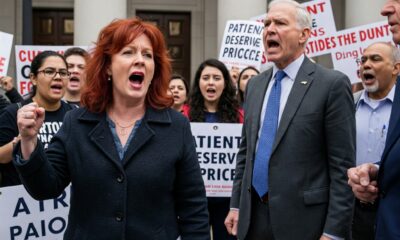Health care
Former Georgia insurance commissioner sentenced to prison after pleading guilty to health care fraud

ATLANTA (AP) – A federal judge on Friday sentenced former Georgia Insurance Commissioner John Oxendine to three and a half years in prison after Oxendine pleaded guilty to conspiracy to commit health care fraud.
US District Judge Steve Jones had one question for the 62-year-old Republican, who was elected to office four times before taking on the failed tax run for governor:
«Why?»
As Jones noted in the Atlanta trial, Oxendine himself received only $40,000 from the project, although Jones ordered him to pay $25,000 and share $760,000 in restitution with Dr. Jeffrey Gallups, who prosecuted health care fraud before he could. even to be accused.
Oxendine replied that he was «very happy» and said he was trying to make his client Gallups happy.
That meant Oxendine stood before Gallup’s doctors at a September 2015 meeting at the Ritz-Carlton hotel in Atlanta and urged them to order unnecessary medical tests on patients and liability insurers, Oxendine said. It also meant that Oxendine devised a plan to raise $260,000 in funding from clinical trial company Next Health through his consulting firm and funnel more money to Gallup, prosecutors said. Oxendine paid $150,000 in charitable contributions and $70,000 in attorneys’ fees to the Gallups, prosecutors said.
Oxendine noted that her father, who was legally blind, served as a judge in Gwinnett County. But Oxendine said that he does not have his duties as a lawyer.
Oxendine told the judge: «I chose to go blind, but I did it myself. «I just sat there; I closed my eyes. I didn’t see my actions and the consequences, and how other people would suffer.»
Defense attorney Drew Findling asked Jones to sentence Oxendine to more than two and a half years, compared to the 3 years and 8 months that prosecutors were seeking. Finding argued Oxendine should not serve the time Gallups, who was sentenced to three years in 2021. Now Gallup is asking that the imprisonment be reduced because he made secret recordings as evidence against Oxendine .
About 60 people sent letters asking for mercy for Oxendine, including family members, lawyers, Rep. former US Bob Barr and insurance commissioners from other countries.
«I know John regrets the decisions he made,» Ivy Oxendine, his wife, told a tearful Jones. «It is his choices that brought him here today. He expressed his sorrow to me and to his children.»
But prosecutors said Oxendine used his position as a lawyer and his political «access» from his four terms as insurance commissioner to commit fraud.
«He could have stopped the plan instead of planning it,» Assistant U.S. Attorney Christopher Huber said. He should have recorded those games instead of collecting them.
Huber noted that this project does not only benefit insurers, but also patients, including the one who received a $18,000 loan.
Prosecutors said Oxendine told Gallups to lie about Gallps’ company manager that the payments from Oxendine were loans. Oxendine told Gallups to repeat the lie when questioned by federal agents, prosecutors said. And they say Oxendine falsely said he did not receive money from Next Health when asked by Atlanta Journal-Constitution.
Jones said Oxendine abandoned his political commitment to advocate for «the guy».
«In this situation, you were not helping this boy,» the judge said. «You were hurting a little guy.»
Jones showed leniency, dropping prosecutors who had asked for $700,000 to $25,000. And after Huber told Jones that the Gallups had paid $197 of the $760,000 shared refund, Jones promised that Gallup would have his payments audited. Oxendine made the first payment of $100,000 on that sum on Friday.
Gallups aside owes $5.4 million after the whistle file a lawsuit he said Gallup defrauded the federal government of the Next Health project and kick-started a private medical device company.
Oxendine ran for governor in 2010 but lost the Republican primary. The Georgia Ethics Commission began investigating campaign finance violations in 2009, accusing Oxendine of using campaign funds to buy a home, lease luxury cars and join a private group.
Oxendine solve the case on commission in 2022, he agreed to donate the remaining $128,000 to his campaign fund if he pleaded not guilty.
He was also accused of accepting financial contributions of $120,000, 10 times the legal limit, from two Georgia insurance companies while running for governor. The judge sentenced the government officials wait too long to pursue Oxendine on those charges.
appId : '870613919693099',
xfbml : true, version : 'v2.9' }); };
(function(d, s, id){
var js, fjs = d.getElementsByTagName(s)[0];
if (d.getElementById(id)) {return;}
js = d.createElement(s); js.id = id;
js.src = "https://connect.facebook.net/en_US/sdk.js";
fjs.parentNode.insertBefore(js, fjs);
}(document, 'script', 'facebook-jssdk'));
#Georgia #insurance #commissioner #sentenced #prison #pleading #guilty #health #care #fraud

Health care
10th Circuit refuses to restore family planning subsidies in Oklahoma | Center for Constitutional Responsibility

(CN) – A three-judge panel of the Tenth Circuit on Monday denied Oklahoma’s request to return millions of dollars in Fund X, which the federal government withdrew after the state Department of Health refused to give patients the number of the landline that was coming. provides information about abortion.
Oklahoma had requested the first order requiring the US Department of Health and Human Services to restore the funds, which are intended to help provide family planning services to low-income and rural residents. On Monday, a federal appeals court upheld a lower court’s decision that denied the request, finding that Oklahoma was unlikely to succeed in its case.
By 2021, Schedule X recipients are mandated by HHS to provide “unbiased, factual information and informal counseling” about all prenatal options and “referrals about all options upon request.”
Oklahoma followed the requirement at first, but only after a decision by the United States Supreme Court Dobbs v. Jackson Women’s Health Organization allowed the state’s abortion ban to begin, Oklahoma stopped referring patients to facilities that provide abortions. The federal Department of Health and Human Services told the state it could meet that need by providing patients with a national hotline that provides unbiased information about all pregnancy options, including abortion. At first Oklahoma agreed, but shortly thereafter stopped following the policy, causing HHS to withdraw Fund X from the state.
Oklahoma argued that requiring it to provide the phone number violates the Weldon Amendment, a federal law that bars HHS funds from going to state agencies that discriminate against health care organizations because of denial. abortion or abortion. The state continued to argue that its health department should be considered a health care facility and that providing a phone number would result in a referral for an abortion.
In a 2-1 decision, the Tenth Circuit disagreed.
«The hotline provided an opportunity to provide neutral information about abortion,» United States Circuit Judge Robert Bacharach, a Barack Obama appointee, wrote in the majority. «Oklahoma rejected the choice of a national telephone number, but did not question the neutrality of the information provided.»
US Circuit Judge David Ebel, appointed by Ronald Reagan, joined Bacharach’s opinion.
But U.S. Circuit Judge Richard Federico, a Joe Biden appointee, argued in a dissenting opinion that requiring Oklahoma to provide a phone number is tantamount to forcing it to provide withdrawal benefits. belly. He argued that Oklahoma offers informal counseling about all pregnancy options available in the state, so the only reason a patient would need to be given a phone number would be to get information about abortion. belly.
«If a patient desires information about non-abortion options, they will not need to be sent to a national hotline,» Federico wrote. On the other hand, if the patient requests a referral, the Oklahoma provider will assume that it is only to review the option of terminating the pregnancy, which the OSDH determined would be contrary to Oklahoma law and policy.
The panel also rejected Oklahoma’s argument that the ordinance violates the Constitution’s Spending Clause, which the Supreme Court has held requires that Congressional conditions for obtaining federal funds not be it is clear. Oklahoma argued that the Title X statute was vague because it did not include a requirement for abortion counseling, but the court found that the statute gave HHS the authority to impose subsidy requirements and that Oklahoma he was clearly aware of the need when he received help. .
The Center for Constitutional Accountability, a liberal advocacy group that filed an amicus curiae brief supporting HHS’s position, issued a press release celebrating the ruling, praising the Tenth Circuit for «rejecting the effort of Oklahoma to twist the U.S. Constitution against reproductive rights.»
«Today’s decision is a victory for reproductive rights, the power of federal agencies to carry out their duties, and the text and history of the Constitution,» said the Center for Accountability’s Appellate Counsel. Constitutional Law Miriam Becker-Cohen said.
Oklahoma, however, has argued that the HHS decision wrongly removes important family planning funding for low-income and rural residents, which Judge Federico said in his dissent.
«Weighing against HHS’s interest is the fact that the elimination of assistance to OSDH reduces access to health care for those who need it most: patients who visit OSDH clinics for health care because, due to resources or geography, is the only option available to them,» wrote Federico.
#10th #Circuit #refuses #restore #family #planning #subsidies #Oklahoma #Center #Constitutional #Responsibility
Health care
The Biden Administration’s proposal addresses maternal mortality, an unsafe community

The Biden-Harris administration unveiled a series of new policy proposals last week that would require hospitals to implement initiatives to improve maternal health and support communities in need.
The proposal introduces new measures for maternity care, such as expanding Medicaid coverage after delivery and implementing new hospital standards. These major changes in health care policy can have significant effects on maternal health outcomes. The proposal comes at a time when threats to abortion care are at the forefront of national debate, with many states imposing restrictive laws that restrict access to reproductive health services.
As journalists, we can help the public understand how these changes may affect them or their communities, as well as the potential long-term effects of these policy changes. Here are some ways we can review policy proposals for our audience:
Story ideas
Included in this plan are other strategies aimed at reducing health disparities within the incarcerated and indigenous population, which are briefly highlighted below.
Key recommendations are outlined
Increasing postpartum Medicaid coverage. For children under 19 on Medicaid or CHIP (health insurance for low-income families), the plan ensures that they remain covered for a full year at a time. This means less paperwork and more consistent care for nearly 40 million children. According to the Kaiser Family Foundation, as of August 2022, nearly 37.8 million children are enrolled in Medicaid (in including Medicaid expansion CHIP), about half of those children in states with 12 months of continuous eligibility and half of states without the policy. This extends the process beyond the usual 60 days postpartum, which is an opportunity to improve access to care for new mothers.
Improving hospital conditions, including maternity care. The proposal outlines changes to how hospitals and surgery centers are paid for outpatient care. This change may affect the types of services provided by these services and the costs associated with them. Medicare spending will reach $944 billion by 2022, which is 21% of the nation’s total health care costs. Medicare covered 65 million people by 2022, and enrollment is expected to reach 78 million by 2030 due to aging.
Also, starting in 2025, there will be a $2,000 cap on out-of-pocket costs for prescription drugs under Medicare Part D. This is due to part of the Affordable Care Act, which President Biden’s law to reduce the cost of drugs, and it could benefit the elderly who spend a lot of money to buy drugs. This is important because in 2021, the 1.3 million Part D enrollees without low-income subsidies had out-of-pocket spending of $2,000.
The proposal also creates new requirements for maternity services, including requiring hospitals to invest in staff and care delivery. This document does not specify what this looks like, but the aim is to ensure that hospitals are prepared to provide emergency obstetric services. This is very important considering that in 2021, the maternal mortality rate in the US was 32.9 deaths per 100,000 births, which is much higher than in other developed countries. Hospitals that do not meet the requirements can be removed from the Medicaid and Medicare programs.
Health care for the incarcerated. The proposal redefines «protection» to remove barriers that prevent formerly incarcerated people from enrolling in and maintaining Medicare coverage. This includes extending eligibility for the special enrollment period to those on parole, probation or house arrest. Contact advocacy groups focused on prison reform for ideas on how these policies can address health disparities.
To support Indian Health Service (IHS) and tribal services. The proposed plan supports IHS and tribal services by increasing Medicare payments for essential, high-cost drugs, including cancer drugs, in IHS and tribal hospital inpatient departments. This project supports Cancer Moonshot’s mission to prevent cancer and improve cancer care for underserved populations.
The comment period for the proposed legislation is open until Sept. 9. To learn more, review the full proposed rule and fact sheets on the Federal Register and CMS websites.
Other resources
#Biden #Administrations #proposal #addresses #maternal #mortality #unsafe #community
Health care
Lower capital gains tax, cuts in food benefits: What the 2025 plan could mean for your wallet in a Trump presidency

Former Republican presidential candidate President Donald Trump speaks at a campaign rally June 22, 2024, in Philadelphia. Trump is seeking to distance himself from a major federal government overhaul planned by some of his administration officials.
Chris Szagola | AP
With the goal of «paving the way for an effective governance system,» the nearly 900-page «order» proposes federal government reform and sweeping policy changes that will affect family taxes, savings and the rest. The Heritage Foundation announced the project in 2022 and announced the policy collection in April 2023.
President Joe Biden and Democrats have pointed to Project 2025 as an example of what a second term from former President Donald Trump could look like. Biden has a page on his campaign website about the project, describing it «as a blueprint for Trump to implement.»
More from Personal Finance:
Here is a breakdown of inflation for June 2024 – in one chart
Gen Zers are poised to buy homes at the top. Some regret the decision
Low inflation indicates little change in the 2025 Social Security cost of living
However, in recent weeks, Trump has made statements that diverge from policy proposals.
«I don’t know anything about Project 2025. I’ve never seen it, I don’t know who’s in charge of it, and, unlike our well-received Republican Platform, it was unrelated too,» Trump wrote on July 11 on The Truth. Community post.
However, while Trump may not approve of this article, its creators have approved of Trump. Several former Trump staffers were involved in the creation of the playbook, and a recently released video from April 2022 shows Trump speaking at a Heritage Foundation event about the team’s plans.
«This is a great team,» Trump can be seen saying, «and they’re going to lay the groundwork and the blueprints for exactly what our organization is going to do and what your organization is going to do when the American people we are giving a grand order to save America.»
The Trump campaign did not respond to requests for comment.
«As we’ve said for more than two years, Project 2025 does not speak for any candidate or campaign,» a Project 2025 spokesperson said in a statement. «We are a coalition of more than 110 groups advocating policy and staff recommendations for the next conservative president.»
«But ultimately it’s up to that president, which we believe will be President Trump, to decide what recommendations he’s going to use,» the organization said.
A spokesperson for Project 2025 said they were not available to comment on specific proposals.
While some of the proposed changes in Project 2025 can happen through executive action, many will require congressional approval, which can be difficult in a divided government.
Here are some of the plans that will affect household finances.
The plan calls for several changes to the Supplemental Nutrition Assistance Program, or SNAP, a federal government program that provides money for low-income people to buy food for themselves and their families.
Under one proposal in Project 2025, multiple recipients could face work requirements in order to receive their benefits. Another plan calls for closing a «loophole» where people can sign up for food stamps if they’re already getting another benefit, such as Temporary Assistance for Needy Families, or TANF.
The Biden administration’s move to increase food stamps for families during the pandemic is being described as an «extraordinary move» by the project’s authors. They also called on the next conservative president to «reject efforts to turn federal school meals into an entitlement program.»
«SNAP/EBT Food Stamp Benefits Accepted» is displayed on a screen inside a Family Dollar Stores Inc. store. Chicago, Illinois.
Daniel Acker | Bloomberg | Getty Images
These changes could have negative effects on families, said Salaam Bhatti, director of SNAP at The Food Research & Action Center.
«Cutting this critical part of our safety net will increase preventable poverty-related hunger, result in negative health outcomes, increase health care costs and reduce efficiency of education among students whose families rely on SNAP to put food on the table,» Bhatti said. .
The 2025 plan calls for major cuts in the US Department of Education’s loan forgiveness programs for student loan borrowers.
It would end the Public Credit Relief Initiative, which provides debt relief to nonprofits and government employees after ten years of payments, and the Borrower Protection Act , which provides a way for defrauded students to get debt relief.
The Biden administration’s new repayment plan for student loan borrowers, known as SAVE, would also end under the project’s provisions.
«If Donald Trump is given the chance to implement this right-wing manifesto, it will destroy the economic stability of millions of borrowers and their families,» said Aissa Canchola Bañez, political director for Protect Borrowers Action.
After 2025, many of the provisions made by Trump in the Tax Cuts and Jobs Act, or TCJA, are set to sunset, including lower tax brackets, a larger itemized deduction, an enhanced child tax credit and credits high quality goods and gifts. others.
While Trump has called for a full extension of the TCJA, the 2025 Plan proposes a «simple dual tax system» of 15% and 30%. The latter would start the base Social Security salary, which is $168,600 for 2024.
The plan would also eliminate many deductions, credits and exemptions, including tax breaks for state and local taxes and education.
If it were to become law, some taxpayers would pay more and others would owe less, depending on their current income, credits, deductions and deductions. of them, explained Howard Gleckman, a senior fellow at the Urban-Brookings Tax Policy Institute.
The second tier could include some form of consumption tax, levied on goods and services, such as a national sales tax, a business transfer tax or others, the plan said.
But historically, «consumption taxes have not been available to Congress,» Gleckman said.
The 2025 plan would cut taxes on capital gains and qualified dividends for high earners. The top rate is currently 20%, and the offer requires 15%.
The plan would eliminate the so-called net investment income tax, or NIIT, an additional 3.8% tax on assets once adjusted gross income, or MAGI, exceeds $200,000 for single filers or $250,000 for couples joining together. Including NIIT, top earners currently pay 23.8% in capital gains.
If enacted, the proposal would represent «a huge tax cut for people who make their money in investments,» Gleckman said.
Although retirement is not a primary goal of the 2025 Plan, the plan requires «global savings accounts,» or USAs, with an annual tax-deductible contribution limit of $15,000, which indexed for inflation.
The tax treatment will be similar to Roth retirement accounts, which offer tax-free earnings after age 59½, with some exceptions. In comparison, the USA would be «more flexible» for investments, and profits could be withdrawn «at any time for any purpose,» according to the plan.
While some policy experts support the USA, others argue that low-income people struggle with voluntary retirement contributions and may not benefit from the proposed annual limits. and a year.
Alicia Munnell, director of the Center for Retirement Research at Boston College, said: «The first of the three points is well taken care of.» «We don’t need to provide any additional funding for that group.»
In a July 9 post on X, Project 2025 said the plan does not advocate reducing Social Security.
But the order describes balancing the federal budget as a «most important goal.»
With growing concerns about the existence of the Social Security fund, «there is no way these two statements match,» Munnell said.
The Social Security Fund has a projected depletion date of 2035, the trustee’s annual report showed in May. This can result in a benefit reduction of at least 20% on that day without action from Congress.
#capital #gains #tax #cuts #food #benefits #plan #wallet #Trump #presidency
-

 Mental health10 meses ago
Mental health10 meses ago7 Magical Rituals That Convince Even the Most Nervous People
-

 Mental health10 meses ago
Mental health10 meses agoThe Playbook Seeking to Transform Cognitive Processing Technology
-

 Nutrition10 meses ago
Nutrition10 meses agoThe Ultimate 7-Day Diet Plan to Lower Triglycerides, Designed by a Nutritionist.
-

 Medication10 meses ago
Medication10 meses agoAngry patients are pushing for new government advocates to lower drug prices
-

 Mental health10 meses ago
Mental health10 meses agoAsking Eric: A chronic cough causes social anxiety
-

 Business1 día ago
Business1 día agoSave Money in the USA: Shield Your Finances from Economic Shifts!
-

 Medication10 meses ago
Medication10 meses agoUdupi: Krishnaveni Ashrayadhamaa, Ayurveda Treatment and Wellness Center established
-

 Mental health10 meses ago
Mental health10 meses agoBetterHelp 101: Understanding Online Therapy and How to Find Support (Sponsored)












